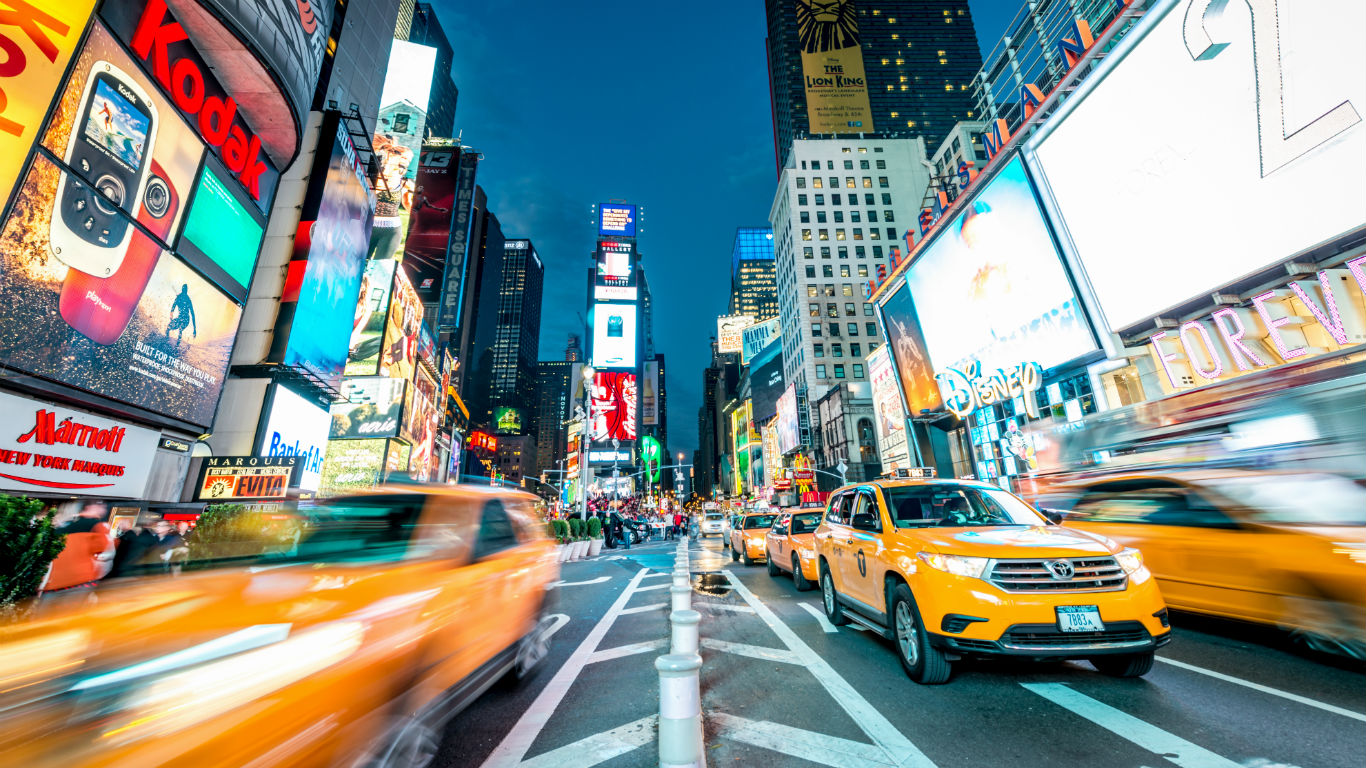
Known as The City That Never Sleeps, it is not surprising that New York has recently appointed a night mayor — a public servant employed to govern the city’s nighttime activities. But the nation’s largest city is not the only place with a nightlife. As the sun sets, night brings to all urban centers an entirely different population with a very different set of characteristics.
In recent years, there has been a resurgence of young, college graduates moving to the downtowns of major cities. While the precise reasons for the shift from suburbanization to urbanization among young professionals are up for debate, one pull factor is the large number of entertainment and nightlife amenities concentrated in city centers.
A growing number of academics and urban planners have turned their attention in the last few decades towards the entertainment and nightlife ecosystem, or night economy. Although definitions of the nighttime economy vary and a lack of data makes the sector difficult to study on a large scale, most researchers agree that the night economy runs from around 6 p.m. to 6 a.m. and encompasses those who enjoy the night, and work during the night.
To highlight the cities investing in nocturnal governance, 24/7 Wall St. considered several factors related to the night economies of the 15 largest U.S. metropolitan areas using data from the U.S. Bureau of Labor Statistics, the U.S. Census Bureau, and other sources.
Click to see the night economies of America’s biggest cities.
Click here to see our detailed findings and methodology.
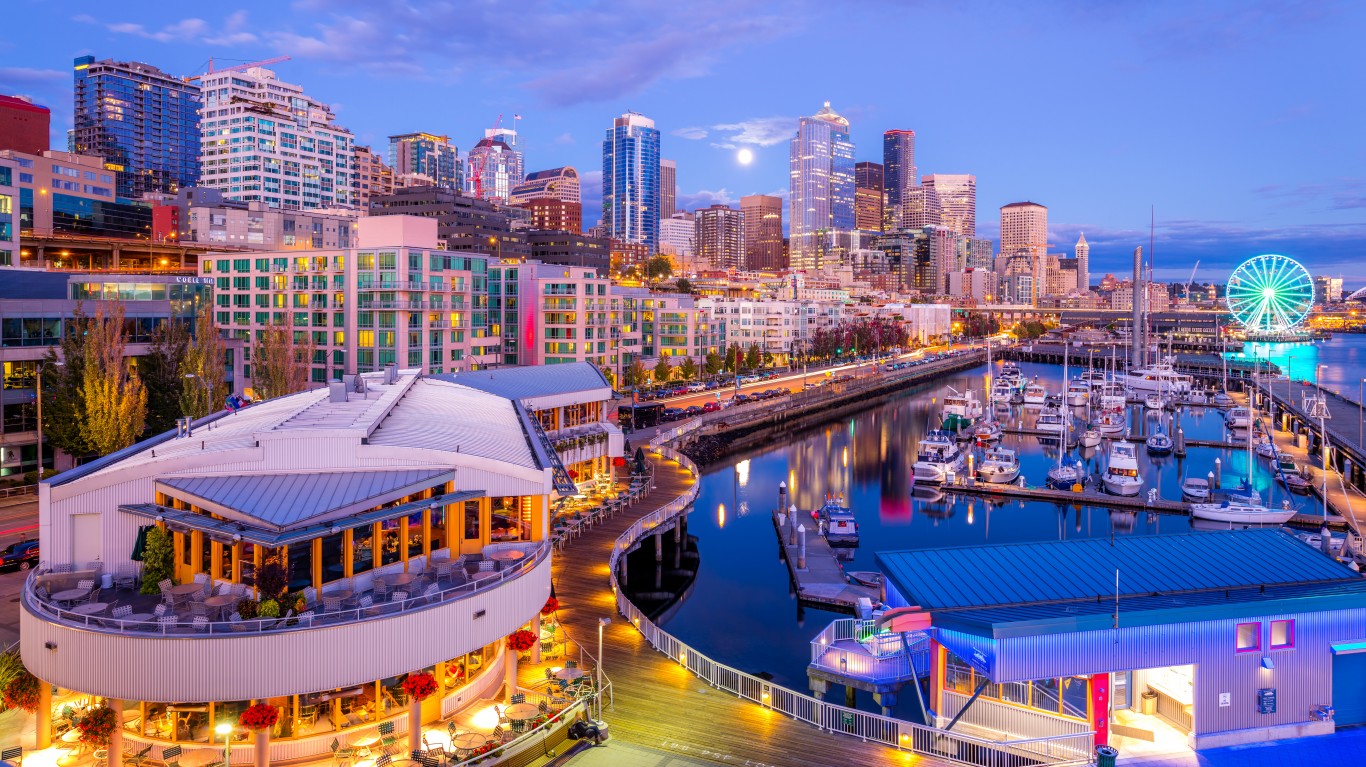
1. Seattle-Tacoma-Bellevue, WA
> Nighttime industries as share of employment: 2.2%
> Most concentrated nighttime industry: Dance companies (396 employees)
> Total population: 3.9 million (586 per sq. mi.)
Seattle is one of several major U.S. cities that in recent years has designated a night mayor or nightlife advocate. Since December 2016, the City of Seattle has employed a nightlife business services advocate, whose responsibilities include helping nightlife establishments navigate the permit and zoning process and ultimately stay in business. The nightlife business services advocate has also organized sexual harassment and opiate overdose trainings, and worked with the transportation department to manage late-night ride shares.
The nightlife business services advocate has also argued against an arcane state tax on aerobics and jazzercise studios that is being applied to music venues. Dance companies are the most concentrated nighttime industry in Seattle, followed by mobile food services.
[in-text-ad]
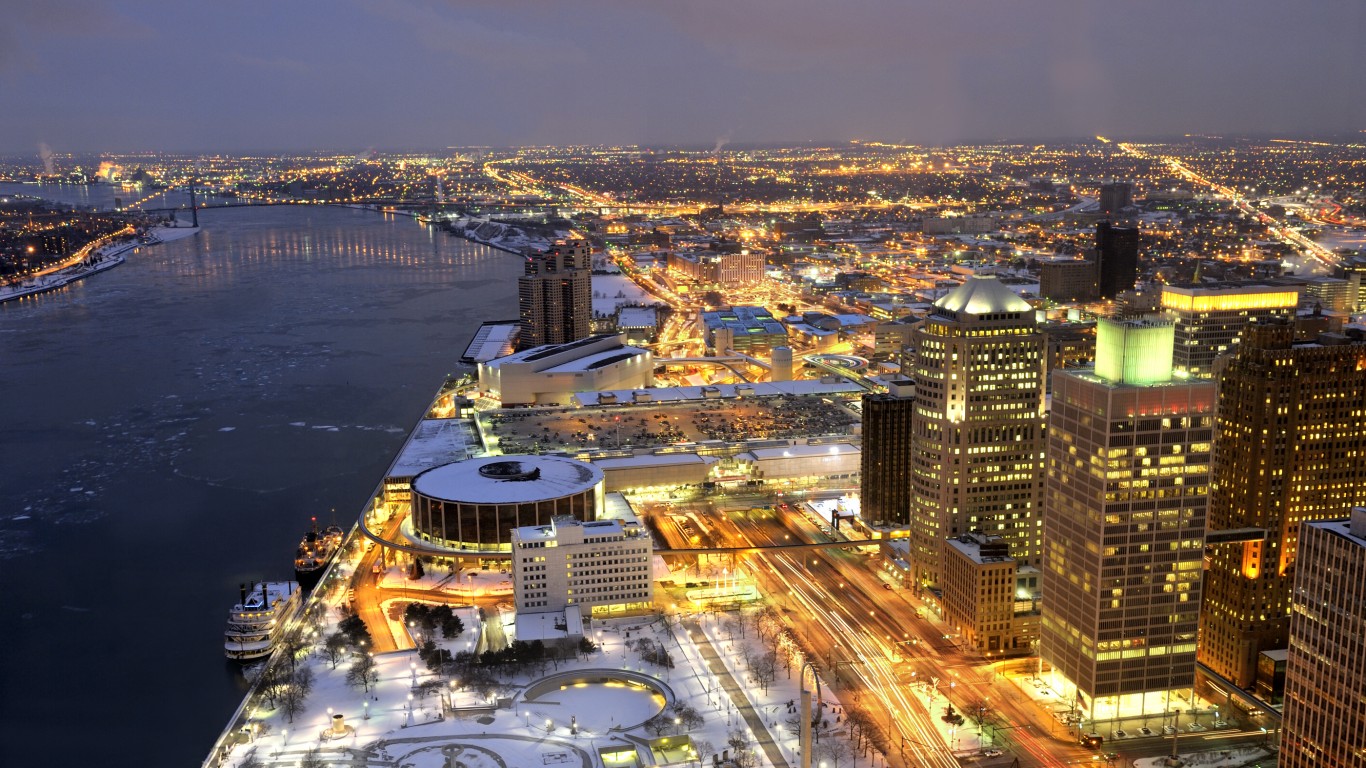
2. Detroit-Warren-Dearborn, MI
> Nighttime industries as share of employment: 1.6%
> Most concentrated nighttime industry: Caterers (4,754 employees)
> Total population: 4.3 million (1,105 per sq. mi.)
Detroit is one of several U.S. metro areas where local government officials are making an effort to manage the nighttime economy. Since May 2018, the City of Detroit has employed a Night Time Economy Ambassador, whose job is to manage and improve relations between businesses operating at night, residents, and government.
One particular challenge to the planning of a 24-hour economy in Detroit is the prevalence of crime in the metro area. The more people there are occupying public spaces, the more safe people tend to feel. On the other hand, some studies have suggested that expansion of nighttime economies can contribute to violence. In 2017, there were 544 violent crimes reported per 100,000 Detroit residents, compared to the national violent crime rate of 383 per 100,000.
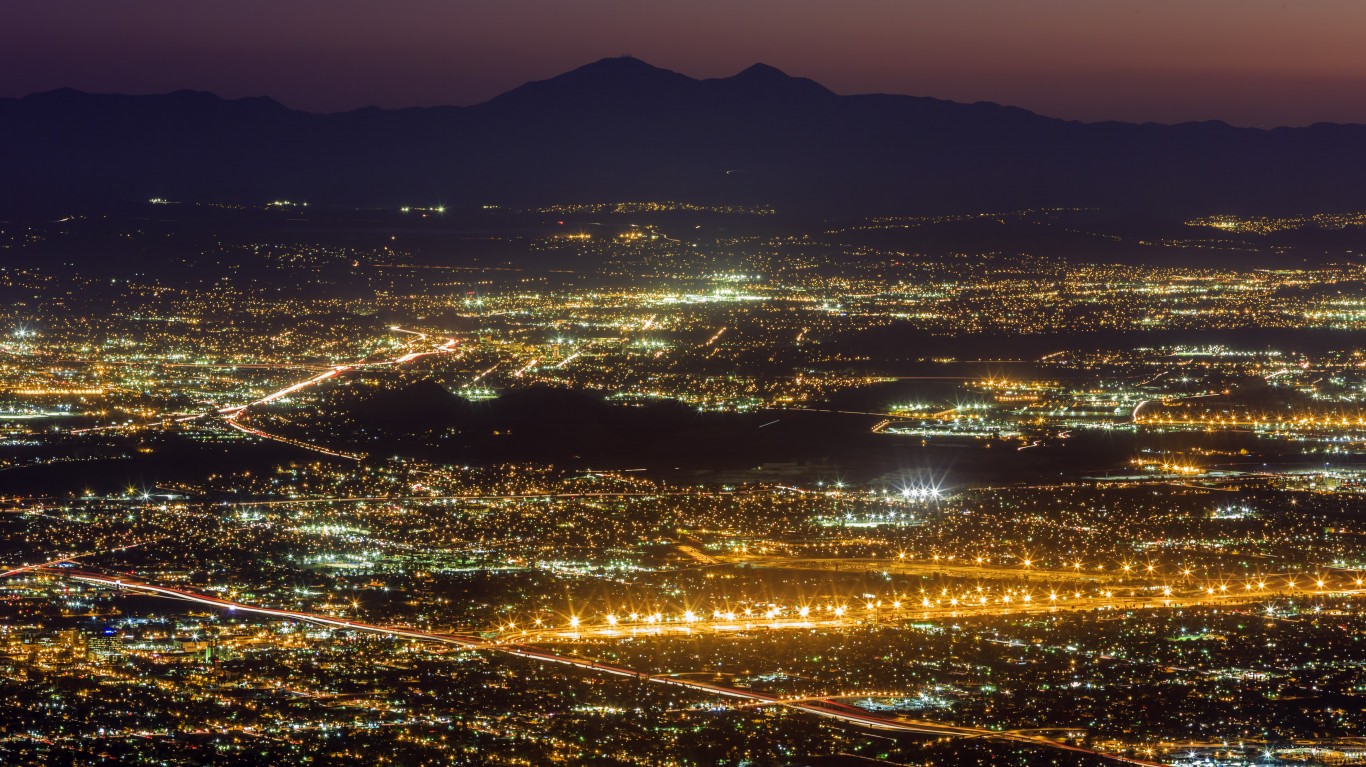
3. Riverside-San Bernardino-Ontario, CA
> Nighttime industries as share of employment: 2.7%
> Most concentrated nighttime industry: Snack and nonalcoholic beverage bars (10,176 employees)
> Total population: 4.6 million (155 per sq. mi.)
With a population of 4.6 million, Riverside is the 13th largest metropolitan area in the country. Even for one of the largest metropolitan areas, it is relatively spread out. There are 155 residents per square mile, less than in the majority of U.S. cities and a fraction of the average density among the 15 largest metropolitan areas.
Because nightlife tends to be more vibrant in denser neighborhoods and cities, Riverside’s low density helps explain its relative lack of nightlife. Nighttime establishments comprise just 1.6% of all businesses in the city, the 14th smallest share nationwide.
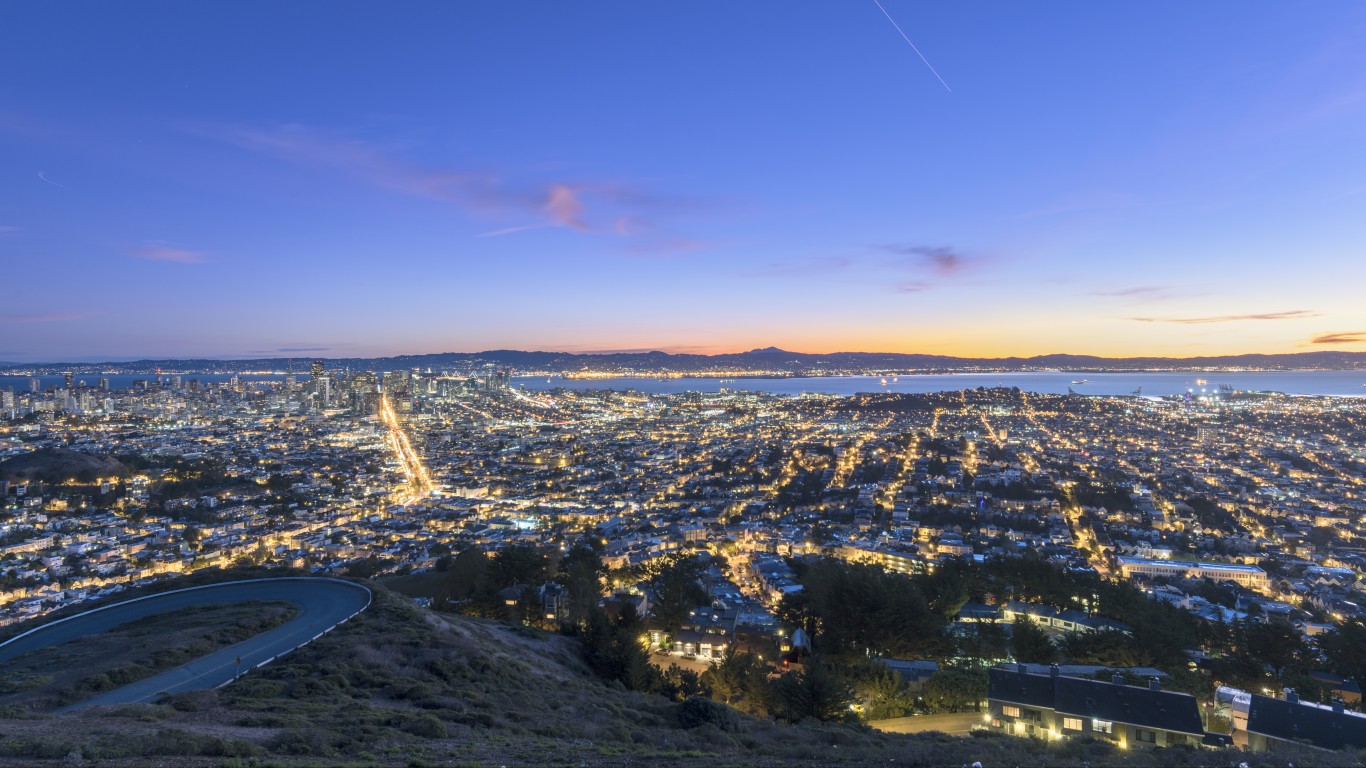
4. San Francisco-Oakland-Hayward, CA
> Nighttime industries as share of employment: 2.0%
> Most concentrated nighttime industry: Dance companies (486 employees)
> Total population: 4.7 million (1,755 per sq. mi.)
In 2003, San Francisco chartered the first Entertainment Commission in the United States. The Entertainment Commission consists of seven members and is responsible for working with venues, festivals, and events, as well as the community to regulate, promote, and enhance entertainment and nightlife throughout the city.
A March 2012 report from the San Francisco government on the impact of nightlife highlights the importance of city’s nighttime economy. According to the report, nightlife establishments generated $6 billion in economic activity in 2015. Bay Area patrons spent an average of $120 each on a night out.
[in-text-ad]
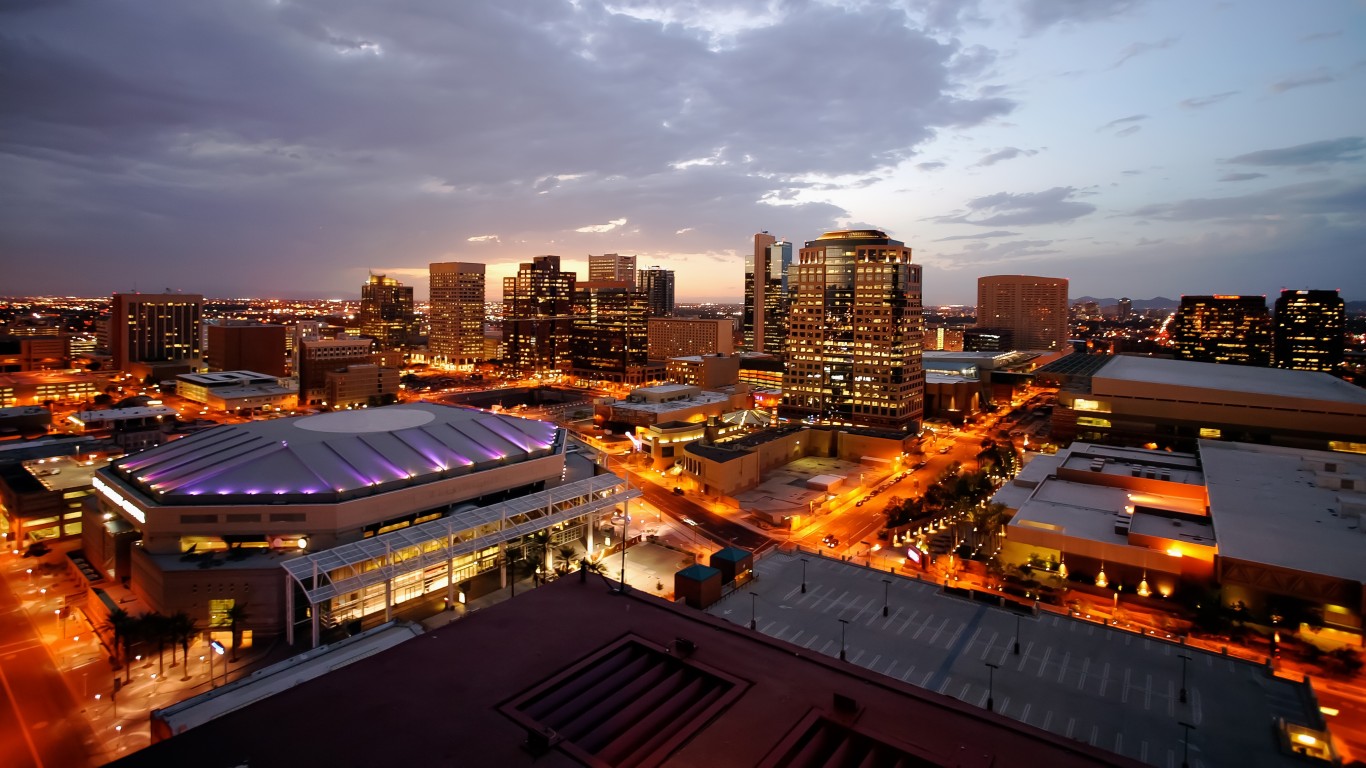
5. Phoenix-Mesa-Scottsdale, AZ
> Nighttime industries as share of employment: 0.9%
> Most concentrated nighttime industry: Sports teams and clubs (3,850 employees)
> Total population: 4.7 million (288 per sq. mi.)
With a population of 4.7 million, Phoenix is the 11th largest metropolitan area in the country. Compared to other large cities, however, Phoenix is relatively spread out. There are just 288 residents per square mile, a fraction of the average density among the 15 largest metropolitan areas.
Density helps boost nighttime economic activity, and the low concentration of people in the Phoenix area may be one reason the city has a smaller nighttime economy than other large cities. Just 0.9% of workers in Phoenix are employed in nighttime industries, less than a third of the 3.6% national figure.
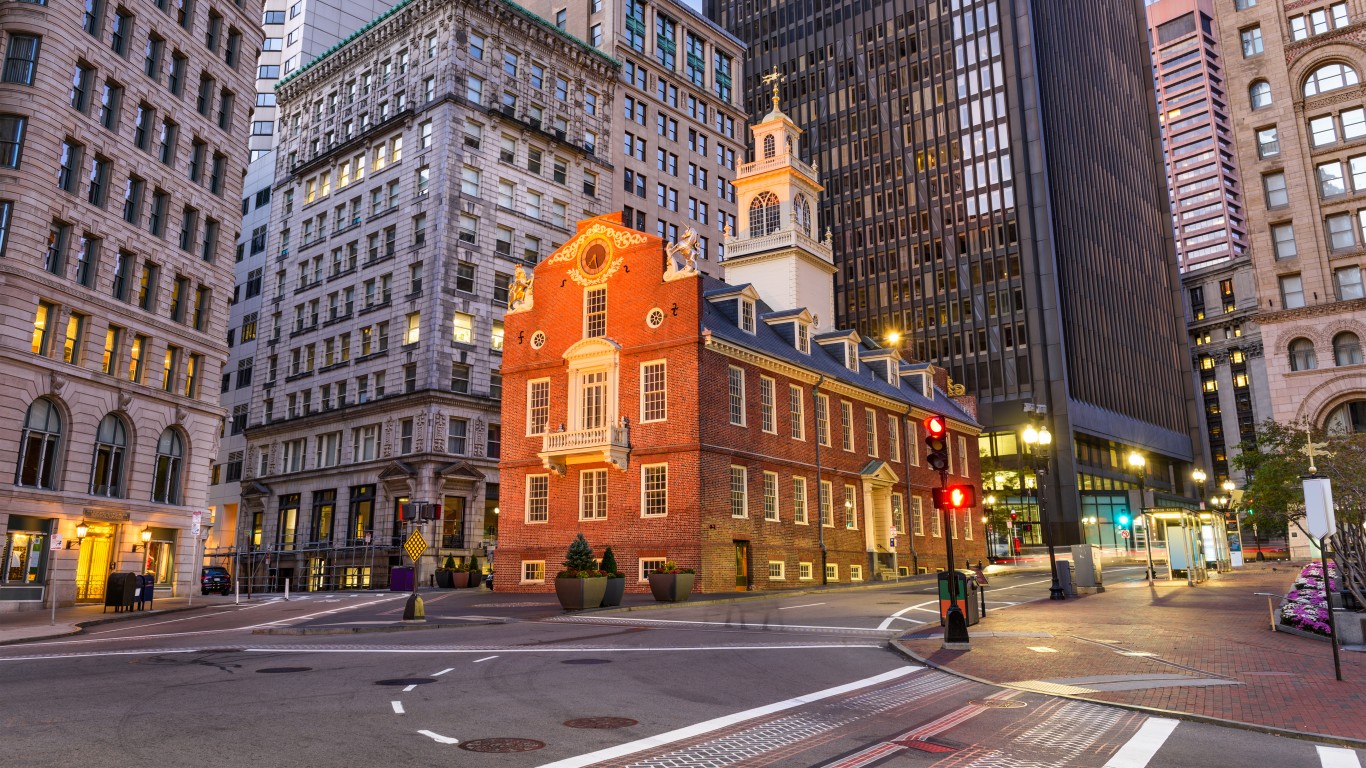
6. Boston-Cambridge-Newton, MA-NH
> Nighttime industries as share of employment: 3.1%
> Most concentrated nighttime industry: Snack and nonalcoholic beverage bars (26,133 employees)
> Total population: 4.8 million (1,305 per sq. mi.)
Home to some of the nation’s best universities, oldest taverns, and most extensive public transit systems, Boston has many of the qualities conducive to a strong nighttime economy. Some 21.4% of adults in the Boston metro area — the city with the heaviest drinkers in the state — report drinking excessively, more than the 18.0% of adults who report heavy drinking nationwide. Additionally, 13.4% of commuters in the metro area use public transit, the third largest share of any city. Efficient public transit helps connect late night patrons to nightlife establishments and promote nighttime economic activity.
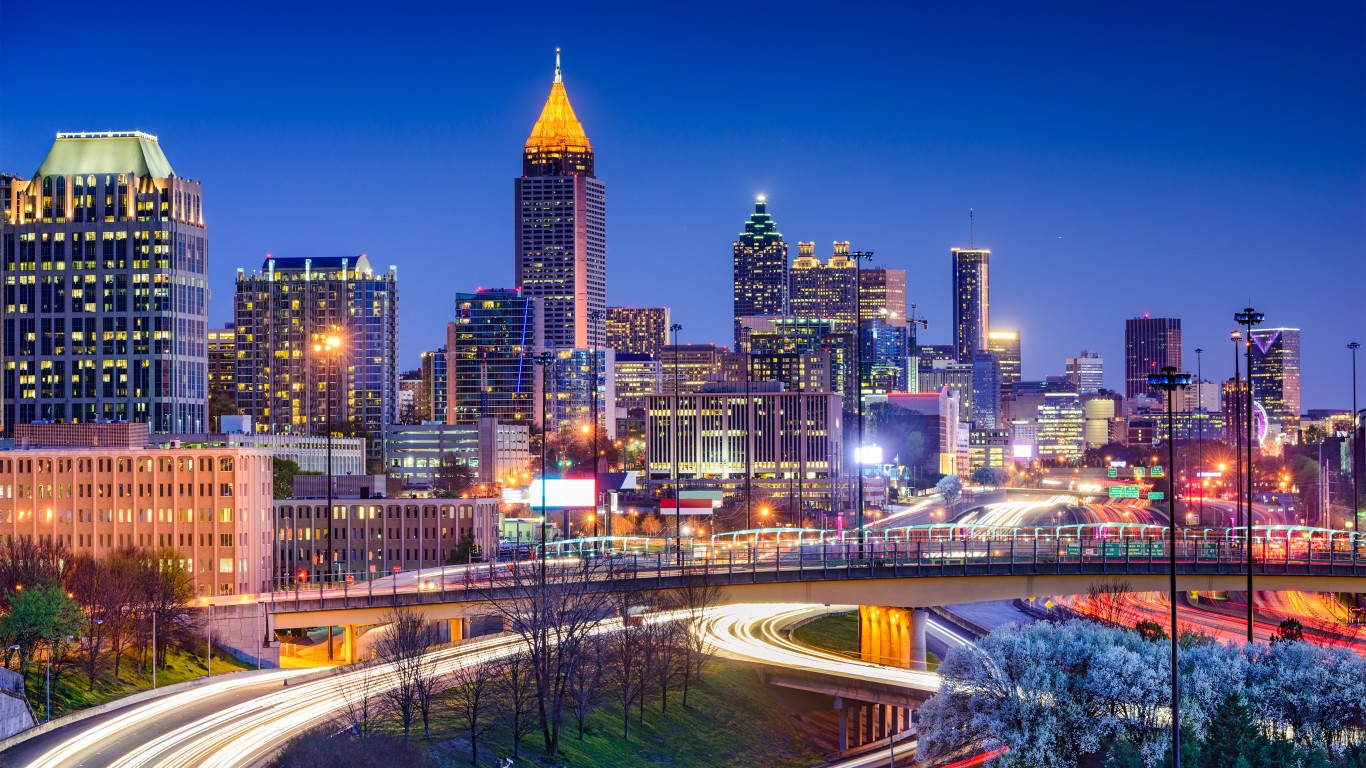
7. Atlanta-Sandy Springs-Roswell, GA
> Nighttime industries as share of employment: 2.7%
> Most concentrated nighttime industry: Bowling centers (1,631 employees)
> Total population: 5.9 million (632 per sq. mi.)
In Atlanta, some of the most concentrated nighttime industries include bowling alleys, amusement arcades, and sports teams and clubs. Some 2.7% of workers in Atlanta are employed in nighttime establishments, more than in a majority of metro areas.
Atlanta has one of the latest last calls of any U.S. city. Bars close at 2:30 a.m., half an hour later than in a majority of the country. During the week of the 2019 Super Bowl, bars were permitted to stay open until 4 a.m. While extended drinking hours can contribute to increased drinking behavior, just 16.5% of adults in Atlanta drink excessively — among the least of any city.
[in-text-ad]
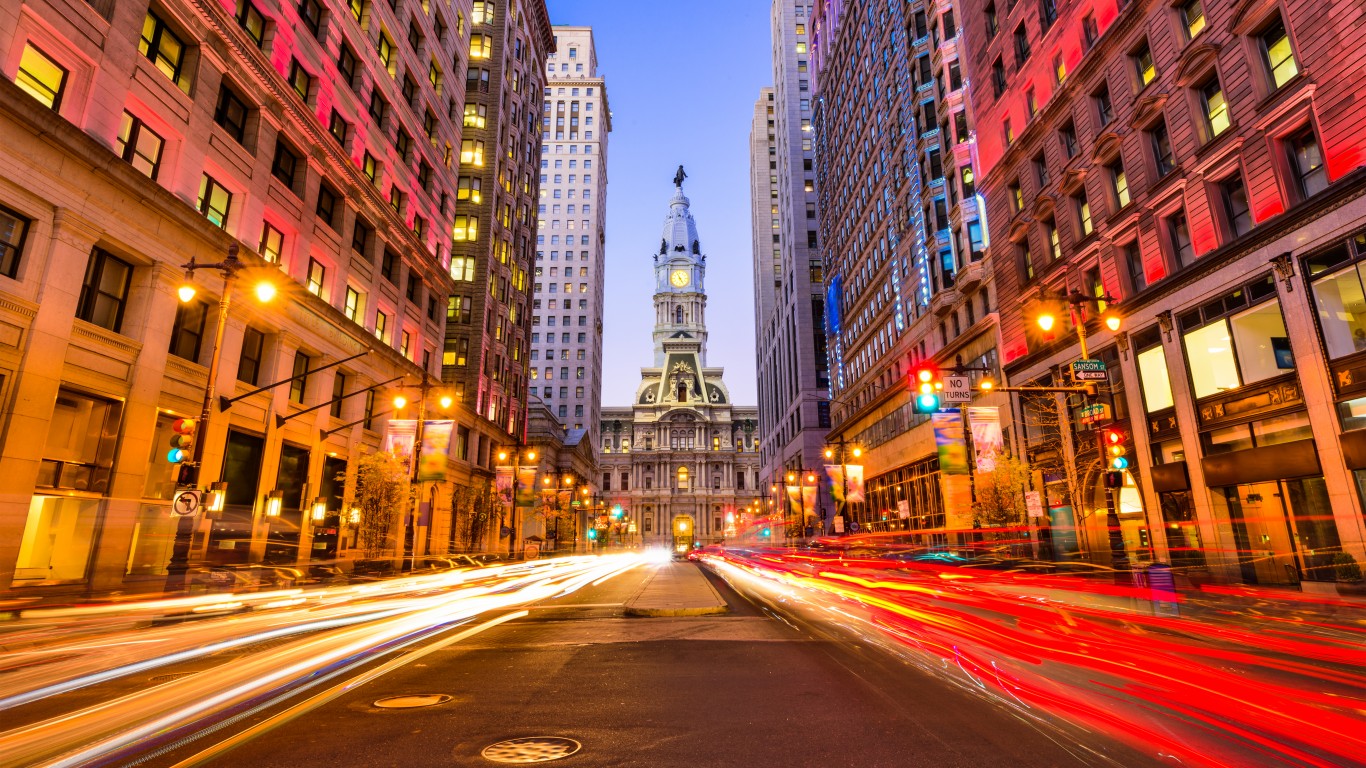
8. Philadelphia-Camden-Wilmington, PA-NJ-DE-MD
> Nighttime industries as share of employment: 2.6%
> Most concentrated nighttime industry: Other spectator sports (669 employees)
> Total population: 6.1 million (1,296 per sq. mi.)
One of the largest, most densely populated cities, Philadelphia has many of the qualities conducive to a strong nighttime economy. There are 1,296 residents per square mile, the eighth most of any U.S. city. Additionally, some 9.0% of commuters in the city use public transit, also the eighth largest share. Efficient public transit helps connect late night patrons to nightlife establishments and promote nighttime economic activity.
Philadelphia has also made modest efforts to grow and manage the nighttime economy. The city established a music industry task force in August 2017, and on multiple occasions it has attempted to extend last call from 2 a.m. to 4 a.m. Currently, the Pennsylvania Liquor Control Board offers “club” liquor licenses that allow select bars to sell alcohol until 3 a.m.

9. Miami-Fort Lauderdale-West Palm Beach, FL
> Nighttime industries as share of employment: 4.0%
> Most concentrated nighttime industry: Racetracks (2,345 employees)
> Total population: 6.2 million (1,096 per sq. mi.)
Miami has one of the latest last calls of any U.S. city. While in a majority of states bars are required to close by 2 a.m., in Miami bars can stay open until 5 a.m. In one small section of downtown Miami, bars and clubs are allowed to operate and serve liquor 24 hours a day.
In 2017, neighboring Fort Lauderdale dedicated $1.4 million to the creation of the Nighttime Economy division of the City Manager’s Office, whose responsibilities include film and event permits, rush-hour traffic congestion management, and the management of ride-sharing in entertainment zones. The team consists of 11 employees and is headed by a Nighttime Economy Manager.
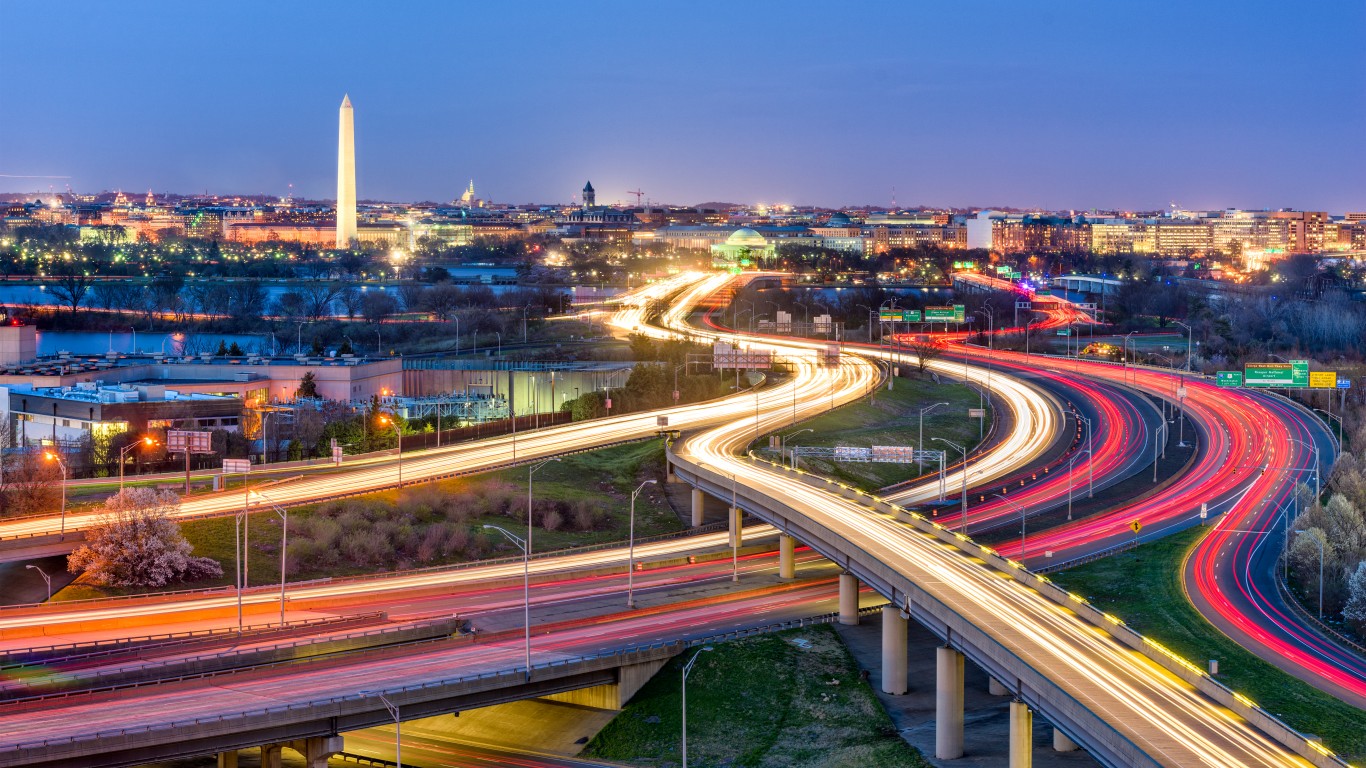
10. Washington-Arlington-Alexandria, DC-VA-MD-WV
> Nighttime industries as share of employment: 3.1%
> Most concentrated nighttime industry: Caterers (5,398 employees)
> Total population: 6.2 million (997 per sq. mi.)
In October 2018, Washington, D.C. established the Office of Nightlife and Culture, a division of the mayor’s office dedicated to promoting the nighttime economy. The team consists of a five-member Commission of Nightlife and is headed by a Director of the Office of Nightlife.
Between 2008 and 2016, the number of active liquor licenses for bars, clubs, and restaurants in D.C. has increased from approximately 800 to more than 1,300. While in a majority of states bars are required to close by 2 a.m., in D.C. bars are allowed to serve alcohol until 3 a.m. on weekends. Bars that provide a written notification and public safety plan in advance are allowed to serve alcohol until 4 a.m. on select holidays throughout the year.
[in-text-ad]

11. Houston-The Woodlands-Sugar Land, TX
> Nighttime industries as share of employment: 2.6%
> Most concentrated nighttime industry: Amusement arcades (881 employees)
> Total population: 6.9 million (674 per sq. mi.)
In the Houston metro area, some of the most highly concentrated nighttime industries include amusement arcades, sports teams and clubs, theater companies and dinner theaters, bars, and bowling centers. Some of the establishments with the most liquor sales in Houston include NRG Park, the Toyota Center, Minute Maid Park, and the House of Blues. These venues frequently host popular late-night events for area residents.
Like most of the largest metropolitan areas in the country, nightlife actually constitutes a relatively small part of the Houston economy. Just 2.6% of workers in Houston are employed in nighttime industries, less than the 3.6% national share.
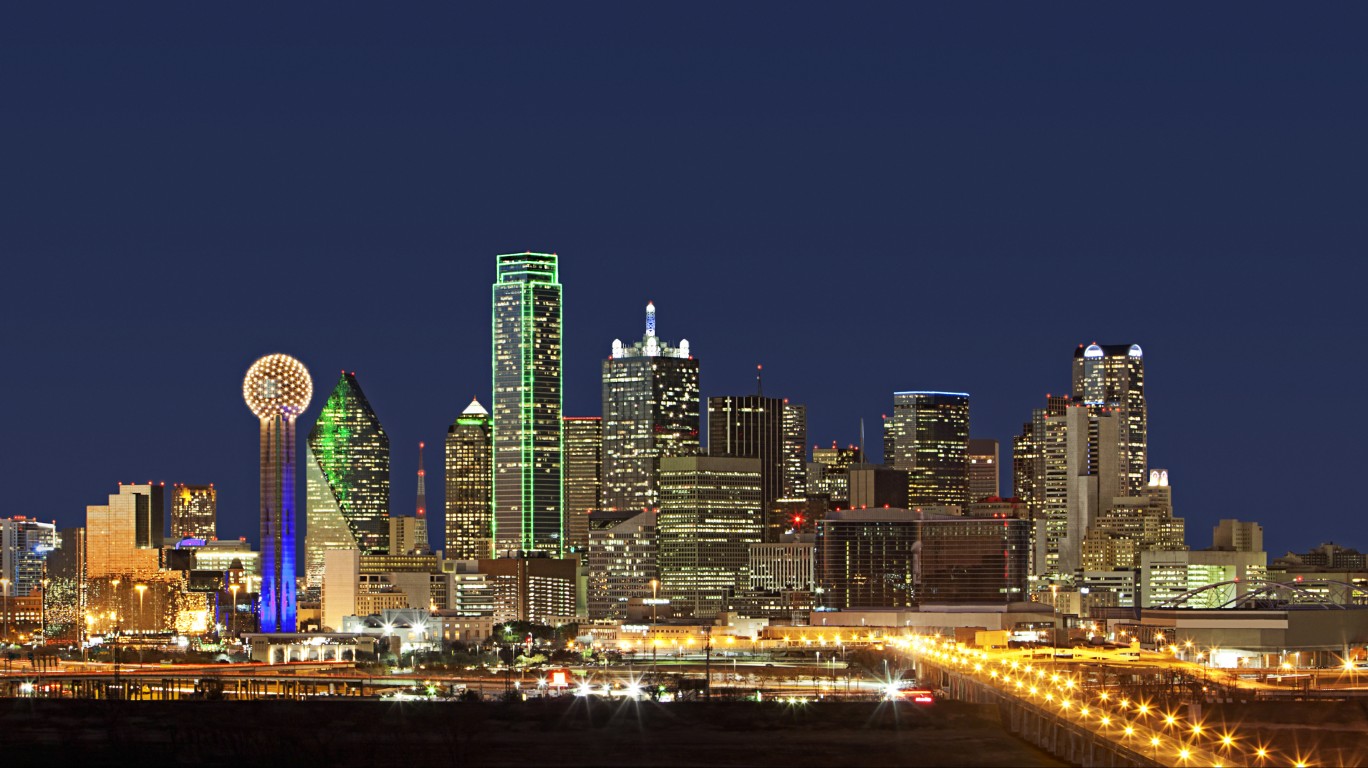
12. Dallas-Fort Worth-Arlington, TX
> Nighttime industries as share of employment: 2.6%
> Most concentrated nighttime industry: Amusement arcades (1,006 employees)
> Total population: 7.4 million (714 per sq. mi.)
Some of the most highly concentrated nighttime industries in the Dallas metro area include amusement arcades, sports teams and clubs, mobile food services, bowling centers, and food service contractors. Some 2.6% of workers in Dallas are employed in nighttime industries, less than the 3.6% national figure.
One challenge to nightlife planning in Dallas is the lack of public transportation infrastructure. Efficient, 24-hour public transportation systems can help safely connect nightlife goers to nightlife establishments and promote nighttime economic activity in general. Just 1.3% of commuters use public transit, a fraction of the 5.0% national share.
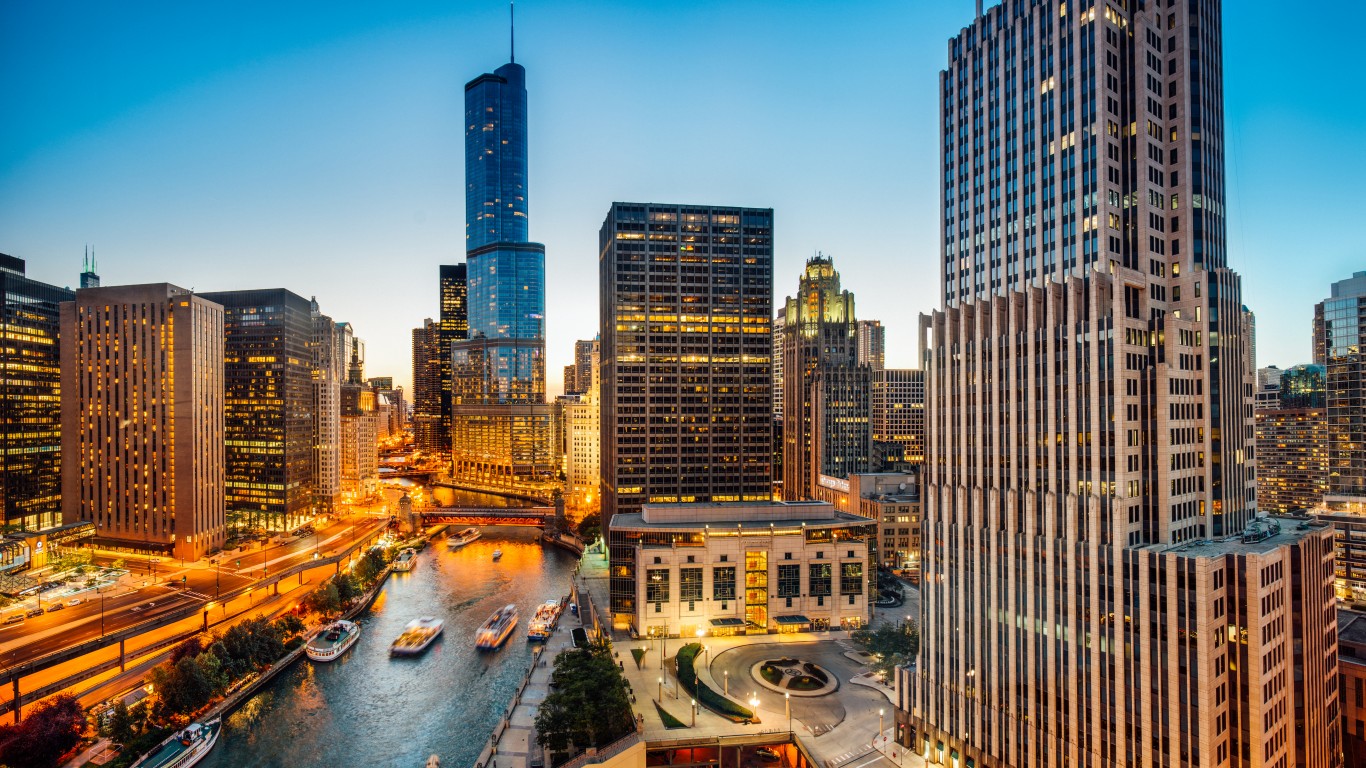
13. Chicago-Naperville-Elgin, IL-IN-WI
> Nighttime industries as share of employment: 3.0%
> Most concentrated nighttime industry: Casinos, except casino hotels (7,645 employees)
> Total population: 9.5 million (1,315 per sq. mi.)
One of the largest drivers of Chicago’s nighttime economy is its casino industry. According to the Bureau of Labor Statistics, some 7,600 workers in the metro area are employed in casinos and casino hotels, accounting for approximately one in 10 casino workers nationwide. While all of the casinos in the Chicago metro area are located on riverboats or on the outskirts of the Windy City, there are a large number of late-night economic activities in downtown proper as well.
Although in Chicago the standard last call is 2 a.m., the city offers a Late Hour Liquor License that allows establishments to serve alcohol until at least 4 a.m. Casinos and late-night liquor licenses may partially contribute to the drinking culture in Chicago. Some 21.6% of adults in Chicago report drinking excessively, more than the national share of 18.0%.
[in-text-ad]
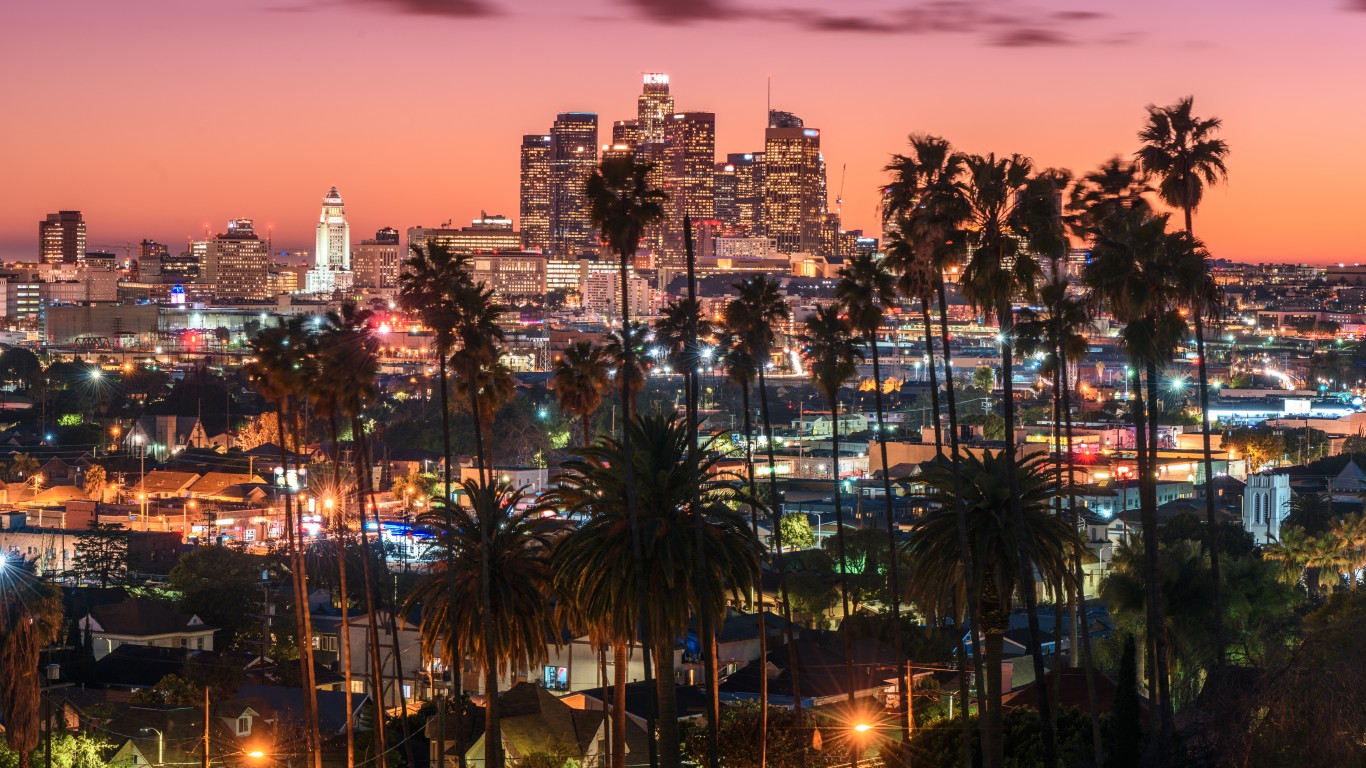
14. Los Angeles-Long Beach-Anaheim, CA
> Nighttime industries as share of employment: 3.4%
> Most concentrated nighttime industry: Independent artists, writers, and performers (11,239 employees)
> Total population: 13.4 million (2,646 per sq. mi.)
Earlier this year, the third iteration of the Last Call Bill, which would allow bars in a number of cities in Los Angeles County to serve alcohol until 4 a.m., received approval from the California Senate and moved to the State Assembly. In response to the bill, researchers from the California-based Public Health Institute conducted a cost-benefit analysis of allowing bars to stay open later, concluding that the costs would outweigh the benefits by a factor of 2.3 to 1.
According to Mirik Milan, the former Night Mayor of Amsterdam — a city which embraced nocturnal governance as early as 2012 when Milan was elected — L.A. is a “tough city to crack,” and it has been relatively resistant to nightlife reform. Other challenges to L.A. nightlife Milan notes in a 2017 Billboard magazine interview include the city’s lack of public transportation options. Just 4.8% of workers commute on public transit, compared to 5.0% nationwide.
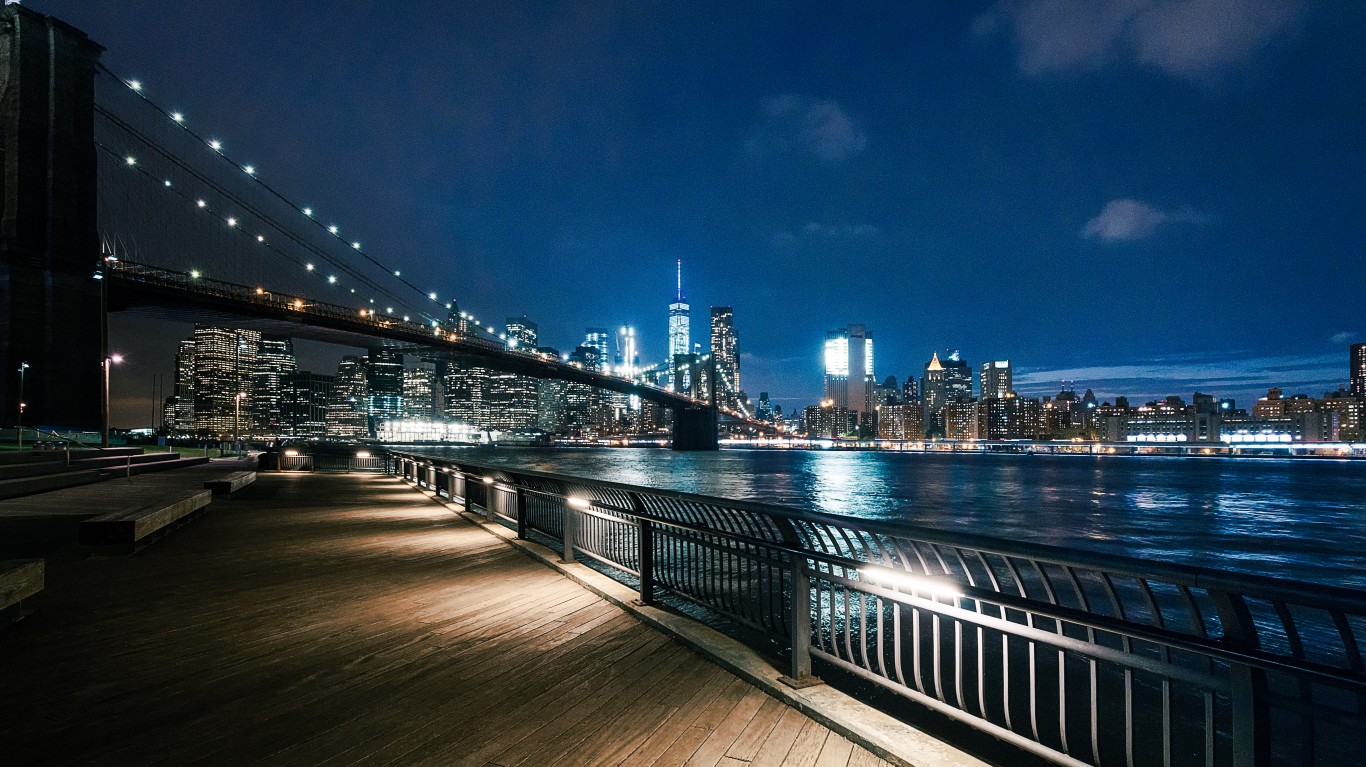
15. New York-Newark-Jersey City, NY-NJ-PA
> Nighttime industries as share of employment: 3.3%
> Most concentrated nighttime industry: Dance companies (2,814 employees)
> Total population: 20.3 million (2,826 per sq. mi.)
In September 2017, New York City established the Office of Nightlife, joining a growing cadre of global cities making outsized efforts to promote and manage the nighttime economy. The office consists of 12 members and is headed by a Nightlife Mayor, appointed in March 2018.
According to an impact assessment of the nightlife economy by the city, the nightlife industry was responsible for $35.1 billion in economic output in 2016. Other factors contributing to nightlife in New York are the city’s 4 a.m. last call, its nation-leading population density of 2,826 people per square mile, and its extensive public transit infrastructure. Some 31.0% of workers commute on public transit, more than six times the 5.0% U.S. figure. Meanwhile, challenges to nightlife in New York — one of America’s least affordable housing markets — include low wages for artists, noise complaints from neighbors, and safety concerns.
Detailed findings and methodology
In an interview with 24/7 Wall St., Andreina Seijas, teaching fellow and doctoral candidate at the Harvard Graduate School of Design, highlighted a number of economic, social, and cultural reasons for the rise in the study of nighttime economies. “Planning should not only be spatial, but also temporal,” Seijas explained. “Nighttime economies contribute billions of dollars to cities, and some cities are trying to measure their size and economic impact.”
According to a report by the City of San Francisco Controller’s Office, the entertainment industry, which includes businesses operating largely at night, generated $6 billion in San Francisco in 2015. In New York, the nightlife industry generated $35 billion in economic output in 2016, according to a study from the NYC Mayor’s Office of Media and Entertainment.
Public transit infrastructure is important to a vibrant nighttime economy. Public transit options can safely connect partygoers with nightlife establishments and can help in reducing late-night congestion from taxis and ride-share services. Cities with the largest shares of residents who use public transit include New York, San Francisco, and Boston.
Public transportation at night is also a social justice issue for those who work at night. “There are many people who have always worked at night, and they deserve to have transportation services like the rest of us,” Seijas explained. “How do these people who live far away get home if there’s no public transportation at night?”
The night economy is also important in its effect as a crime deterrent. In a reference to urban activist Jane Jacobs, Seijas noted how “cities that are more active at night feel safer.” While some studies have suggested that the expansion of nighttime activity can contribute to alcohol-induced violence, others have observed that having more “eyes on the street” at night can help deter crime. The effect that increased nighttime activity has on crime can be influenced through proper urban planning and management. “You cluster nighttime activity, and then you make those clusters safe,” said Seijas. For more on crime in U.S. cities, see the most dangerous city in every state.
The growing emphasis on nighttime economies has led to the creation of a number of nightlife-related positions and organizations in municipal governments throughout the world. In 2003, San Francisco chartered the Entertainment Commission, a first-of-its-kind organization responsible for working with venues, festivals and events, as well as the community to regulate, promote, and enhance entertainment and nightlife throughout the city. Other major cities with nightlife mayors or other nighttime-focused planning bodies include Seattle, Detroit, Miami, Washington, D.C., and New York.
To analyze the night economies of every major U.S. city, 24/7 Wall St. reviewed the share of the workforce employed in “nighttime” industries in the 15 largest metropolitan areas in the country by population with data from the U.S. Bureau of Labor Statistics and the U.S. Census Bureau. Data on employment, establishment count, and annual wage came from the Quarterly Census of Employment and Wages of the Bureau of Labor Statistics and is for 2018. Industry concentration of nighttime industries was determined via location quotient by comparing the local industry share of employment to the national share. Data on population and the share of workers 16 and over who commute using public transit came from the U.S. Census Bureau’s American Community Survey and is for 2017. Data on the share of adults over 18 who drink excessively came from County Health Rankings & Roadmaps, a Robert Wood Johnson Foundation and University of Wisconsin Population Health Institute joint program. Data on violent crime came from the FBI’s Uniform Crime Report and is for 2017. Data on population density came from the Census Bureau’s 2010 decennial census.
“Nighttime” industries include theater companies and dinner theaters, dance companies, musical groups and artists, other performing arts companies, sports teams and clubs, racetracks, other spectator sports, independent artists, writers, and performers, amusement and theme parks, amusement arcades, casinos, except casino hotels, other gambling industries, bowling centers, hotels and motels, except casino hotels, casino hotels, bed-and-breakfast inns, food service contractors, caterers, mobile food services, drinking places, alcoholic beverages, and snack and nonalcoholic beverage bars. The “nighttime” industry classification was based on similar analyses by the City of San Francisco Controller’s Office and the NYC Mayor’s Office of Media and Entertainment.
Are You Ahead, or Behind on Retirement? (sponsor)
If you’re one of the over 4 Million Americans set to retire this year, you may want to pay attention.
Finding a financial advisor who puts your interest first can be the difference between a rich retirement and barely getting by, and today it’s easier than ever. SmartAsset’s free tool matches you with up to three fiduciary financial advisors that serve your area in minutes. Each advisor has been carefully vetted, and must act in your best interests. Start your search now.
Don’t waste another minute; get started right here and help your retirement dreams become a retirement reality.
Thank you for reading! Have some feedback for us?
Contact the 24/7 Wall St. editorial team.
 24/7 Wall St.
24/7 Wall St. 24/7 Wall St.
24/7 Wall St.

